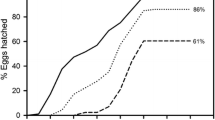Abstract
Amictic females of a clone of S. pectinata from Star Lake (Norwich, Vermont) may produce diapausing as well as non-diapausing (subitaneous) eggs. The proportion of diapausing eggs produced in cultures was unaffected by temperature (12 vs 19 °C) or rotifer population density (minima of 0.33 vs 3 ind. ml−1) at 19 °C. However, at 19 °C this proportion was higher in cultures maintained at a low food level suppressing reproduction (5 × 103 cells ml−1 Cryptomonas erosa) than in those maintained at a high food level (2 × 104 cells ml−1); the treatment effect was marginally significant (p=0.067). Consistent with the effect of low food availability, a period of starvation was very effective in inducing the development of diapausing eggs. None of 19 females cultured individually from hatching at 19 °C on C. erosa (2 × 104 cells ml−1) in 1-ml volumes produced any diapausing eggs in 4 days (0 out of 349 eggs), while 13 out of 16 females subjected to a 15-hour starvation period 6 hours after birth produced one or more diapausing eggs during that time (34% of the 158 eggs produced by the 16 females were diapausing). Diapausing eggs produced and left at 19 °C hatched after 4 to 13 days. Those produced in cultures with a low food level took significantly longer to hatch (9.7 days) than those produced in cultures with a high food level (8.1 days) (p=0.022). In natural communities, S. pectinata should be able to respond directly and rapidly to poor food conditions by producing eggs that undergo an obligatory dormant period before resuming development.
Similar content being viewed by others
References
Gilbert, J. J., 1980. Some effects of diet on the biology of the rotifers Asplanchna and Brachionus. In D. C. Smith & Y. Tiffon (eds), Nutrition in the lower Metazoa. Pergamon, Oxford & New York: 57–71.
Gilbert, J. J., 1994. Susceptibility of planktonic rotifers to a toxic strain of Anabaena flos-aquae. Limnol. Oceanogr. 39: 1286–1297.
Gilbert, J. J. Structure, development and induction of a new diapause stage in rotifers. Freshwat. Biol. in press.
Koste, W., 1978. Rotatoria. Die Radertiere Mitteleuropas. 2 vols. Borntraeger, Stuttgart.
Ruttner-Kolisko, A., 1946. Über das Auftreten unbefruchteter ‘Dauereier’ bei Anuraea aculeata (Keratella quadrata). Osterreichische Zool. Zeit. 1: 179–191.
Stemberger, R. S., 1981. A general approach to the culture of planktonic rotifers. Can. J. Fish. aquat. Sci. 38: 721–724.




